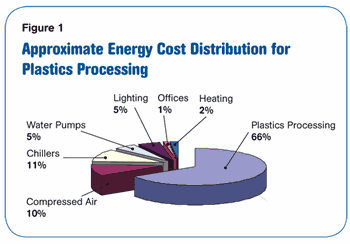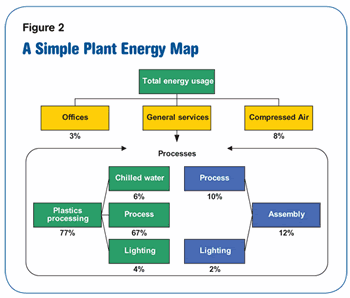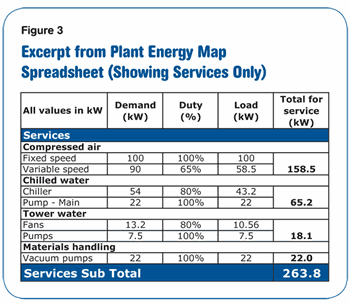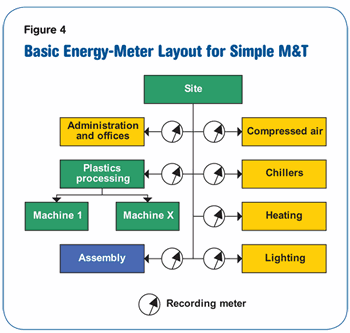Where Are You Using Energy?
Few plants are able to accurately divide up their energy consumption by where it occurs, despite the fact that this is relatively easy to do.
Few plants are able to accurately divide up their energy consumption by where it occurs, despite the fact that this is relatively easy to do. A basic understanding of the reasons for energy usage will inform plant managers on where they should focus their energy-reduction efforts. Those efforts should normally be in proportion to the amount of energy usage and/or the ease of implementation. There is no sense carrying out large projects and spending large amounts of time in areas that use only small amounts of energy.
The approximate energy cost distribution for plastics processing is shown in Fig. 1. The exact percentages for each individual plant will depend on the processes used there. For instance, compressed-air usage is normally higher in blow molding operations and those where a large amount of assembly work is performed, while cooling is normally higher in extrusion lines. Despite such variations, the ratios in Fig. 1 will be approximately correct for the majority of plants.
ENERGY MAPPING
The best and easiest method to determine where energy is being used is to create an “Energy Map” for the plant. Figure 1 provides a rough approximation, but a more detailed evaluation is needed for effective targeting of action.
A simple plant Energy Map will reveal the areas of high energy usage and allow targeting of improvement efforts in the most rewarding areas. Such a map is generally easily prepared by the plant electrician. A typical map is shown in Fig. 2.
The simplest method to determine the energy use at a plant is to count the kilowatt or horsepower ratings of the main process motors, services, and other major energy consumption areas. Lighting loads can be quantified by simply counting the number of lightbulbs and multiplying by the wattage of each bulb.
These kilowatt values can be entered into a spreadsheet, and factors can be applied for the relative duty of the motor, service, or lightbulb in terms of percent usage or operational hours/year (Fig. 3). Initially, these usage values can be estimates: The map simply needs to be accurate enough to reflect the relative energy usage. This process will give a first approximation of the relative magnitude of the various areas of energy use at the plant.
The total of these values (main process, process services, and plant services) should be subjected to a reality check by comparing the overall energy usage of the plant. Large discrepancies generally indicate motors that have been overlooked or loadings that have been miscalculated.
We have performed this exercise with electricians at many plants and found it rarely takes more than an hour to complete the basic map. The actual site usage is usually within ±5% of the predicted usage from the Energy Map. But the results are always revealing and always result in a change in the plant’s focus in terms of efforts and spending on energy reduction.
Tip: A simple walk-around to identify the major energy-usage areas in a plant will often identify hidden usage that was never really considered before.
Tip: Many energy surveyors who are unfamiliar with plastics processing and do not carry out energy mapping get excited about lighting and heating. This is a sure sign that they have a lot to learn. The main energy use in processing is in machinery and services (93%). Lighting, heating and offices are minor.
ENERGY MONITORING & TARGETING
The concept of monitoring and targeting (M&T) is used to focus attention on energy consumption and identification of cost-reduction opportunities with attractive returns on investment. Energy M&T is the collection, interpretation, and reporting of information on energy use. It measures and maintains performance and locates opportunities for reducing energy consumption and cost. In previous articles in this series, we looked at using the Performance Characteristic Line (PCL) and benchmarking as the first steps, but the Energy Map and basic M&T provide the next level of information.
Gathering data will not, in itself, provide results. The potential benefits of energy efficiency cannot be achieved by collecting large amounts of data or preparing lengthy reports. Data is meaningless without careful analysis, and reports are useless if they are not targeted at people with the authority and the will to act.
For any plant, the amount of M&T must be appropriate to the energy expenditures. M&T may require improved metering capability for cost allocation. At today’s costs for simple meters, the rational decision is not whether to install meters to allow a breakdown of the usage and the costs, but how many meters are needed and where to put them.
SUB-METERING
Recording energy usage simply from the main meter or the billing data does not give managers sufficient information. A basic meter layout for M&T (Fig. 4) will allow cost allocation to the various process areas and assessment of the services load for cost allocation.
New-style, low-cost meters can be connected using wireless or Ethernet technology to allow dynamic measurement and control of energy. These technologies are giving rise to the concept of “aM&T” (automated monitoring and targeting). This can be extended to low cost sub-metering for individual machines. This type of sub-metering enables a site to allocate costs and responsibility based on the real energy usage of both machines and dedicated services.
Next, we’ll look at one of the real energy hogs in plastics plants—compressed air.
About the Author
Dr Robin Kent is founder and managing director of Tangram Technology Ltd. in Hitchin, Herts., U.K. Tangram provides consulting and training in plastics engineering and design. Kent has 36 years’ experience in injection molding and extrusion as technical director for several processing companies in Europe. Articles in this series are adapted from Energy Management in Plastics Processing (2008, 265 pages, pidbooks.com). Contact rkent@tangram.co.uk or visit tangram.co.uk.
Related Content
Formulating LLDPE/LDPE Blends For Abuse–Resistant Blown Film
A new study shows how the type and amount of LDPE in blends with LLDPE affect the processing and strength/toughness properties of blown film. Data are shown for both LDPE-rich and LLDPE-rich blends.
Read MoreThe Importance of Viscosity in Melting
The calculations required to determine the right melt temperature for each polymer are complicated. Knowing the power-law coefficient and the consistency index of the polymer you run might prove useful.
Read MoreTroubleshooting Screw and Barrel Wear in Extrusion
Extruder screws and barrels will wear over time. If you are seeing a reduction in specific rate and higher discharge temperatures, wear is the likely culprit.
Read MoreHow Much L/D Do You Really Need?
Just like selecting the extruder size and drive combination, the L/D should be carefully evaluated.
Read MoreRead Next
How Polymer Melts in Single-Screw Extruders
Understanding how polymer melts in a single-screw extruder could help you optimize your screw design to eliminate defect-causing solid polymer fragments.
Read MoreAdvanced Recycling: Beyond Pyrolysis
Consumer-product brand owners increasingly see advanced chemical recycling as a necessary complement to mechanical recycling if they are to meet ambitious goals for a circular economy in the next decade. Dozens of technology providers are developing new technologies to overcome the limitations of existing pyrolysis methods and to commercialize various alternative approaches to chemical recycling of plastics.
Read More










.png;maxWidth=300;quality=90)
















